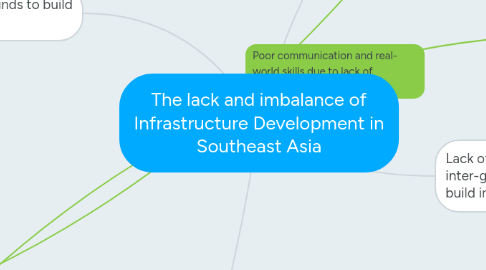
1. Insufficient Funds to build infrastructure
1.1. Poor allocation of funds by the government
1.1.1. Lack of planning out financial needs
1.1.1.1. Financial needs of coastal nations with unexpected climates, events and instability are difficult to predict
1.1.2. More funds used to invest outside of the country rather than within
1.1.2.1. Major source of GDP is export and agriculture in Southeast Asian countries
1.1.2.1.1. It looks like it isn't necessary to invest within the country is most earnings are coming from outside
1.1.3. Heavy dependence on outside capital and on banks
1.1.3.1. Banks vulnerable to periodic crises
1.1.3.1.1. Therefore, banks are asking for higher capital requirements due to the long-term financing
1.1.3.2. Infrastructure has high sunk costs
1.1.3.2.1. A form of capital, and is a long lasting investment
1.1.3.2.2. high dependence on its complementary inputs as well
1.2. Low-income nations aren't capturing a larger amount of global trade flows
1.2.1. Landlocked nations don't have many ports or export and import facilities
1.2.2. Lack of teamwork between larger nations like India, China, Japan and smaller southeast asian countries
1.2.2.1. Chinese and Japanese banks provide cheap financing for these projects but Southeast Asian countries need companies to help lead and facilitate these projects
1.2.2.1.1. Causes labour migration
1.2.2.1.2. Need labour from other nations
1.3. Many of the materials/equipment needed to build is unaccessible
1.3.1. Main focus of goods and services in Southeast Asia are agriculture and export items
1.3.1.1. Larger machinery needed to build hard infrastructure isn't present
1.3.1.2. This is because it is the main source of GDP
1.3.1.2.1. Nations don't realize that with smoother infrastructure their transport, production and selling of products will be a lot easier
1.3.2. Government is allocating its money to public heath and disaster funds and more social and public purposes
1.3.2.1. This is because of the risk factors of living in such nations
1.3.2.1.1. Political instability
1.3.2.1.2. Poor climate and terrain conditions
1.3.2.2. Governments lack the understanding that soft and hard infrastructure can greatly benefit nations
2. Don't have the right labour and skills to complete an infrastructure project
2.1. Uneducated citizens
2.1.1. Most Southeast Asian countries have high primary and secondary school completion rates, however low post-secondary education rates
2.1.1.1. Cost of colleges and universities
2.1.1.2. Lack of good colleges and universities in these nations
2.1.1.2.1. Low income for teachers and professors giving them few incentives to come teach in rural areas
2.1.1.3. Need to earn money for family to have sustainable living and a better lifestyle
2.2. Lack of critial thinking and problem solving approach
2.3. Lack of white collar workers to manage projects
3. Poor climate and terrain conditions to build infrastructure
3.1. Most land used towards agriculture
3.1.1. Prevents countries from producing technologically advanced goods
3.1.1.1. Makes the country one step further from urbanization and producing modern consumer goods
3.2. Risk of coastal hazards (tsunamis, hurricanes, heavy rainfall)
3.2.1. Due to geographical location of countries
4. Lack of regulatory bodies and inter-government communication to build infrastructure
4.1. Governments aren't allocating their time and funds appropriately
4.1.1. Corruption
4.1.1.1. Salary is fairly low and insufficient for cost of living
4.1.1.2. Three Southeast Asian nations -- Cambodia, Laos and Myanmar -- rank among the 30 most corrupt countries in the world, while one -- Singapore -- is among the 10 least corrupt
4.1.1.2.1. Singapore is one of the most developed nations in Southeast Asia with great infrastructure, facilities and quality of life
4.1.1.2.2. Cambodia, Laos and Myanmar have poor working and living conditions with a low GDP as well
4.2. No regulatory body to oversee infrastructure built BETWEEN nations
4.2.1. Countries have language and cultural barriers
4.2.2. Countries have different needs that they need to complete first before working with other nations
4.2.2.1. Countries haven't been working parallel to each other this whole time, so now their needs are different
4.2.2.1.1. This is because they all have different demographical, political, social and economic situations (that's what makes countries different from each other)
4.2.3. UNESCAP, the United Nations Economic and Social Commission of Asia and Pacific and ASEAN don't have much control
4.2.3.1. Can suggest ideas and subcommittees, but cannot implement a lot of actions and regulatory bodies due to lack of rank in UN
4.3. Regional governments have dedication but not the right resources to oversee projects
4.3.1. Lack of education, skills and exposure to lead projects
4.3.1.1. Southeast Asian underdeveloped nations have a lot of blue-collar workers but require more white collar workers to lead projects
4.3.1.1.1. These white collar workers come in from developed cities like Hong Kong, Shanghai, Beijing, leaving underdeveloped nations where they are
4.3.2. Leave most projects half done and don't follow through
4.3.2.1. A political, economic or social situation comes up haltering the process
4.3.2.2. There is some sort of argument, confusion or disagreement that results in projects being abandoned
